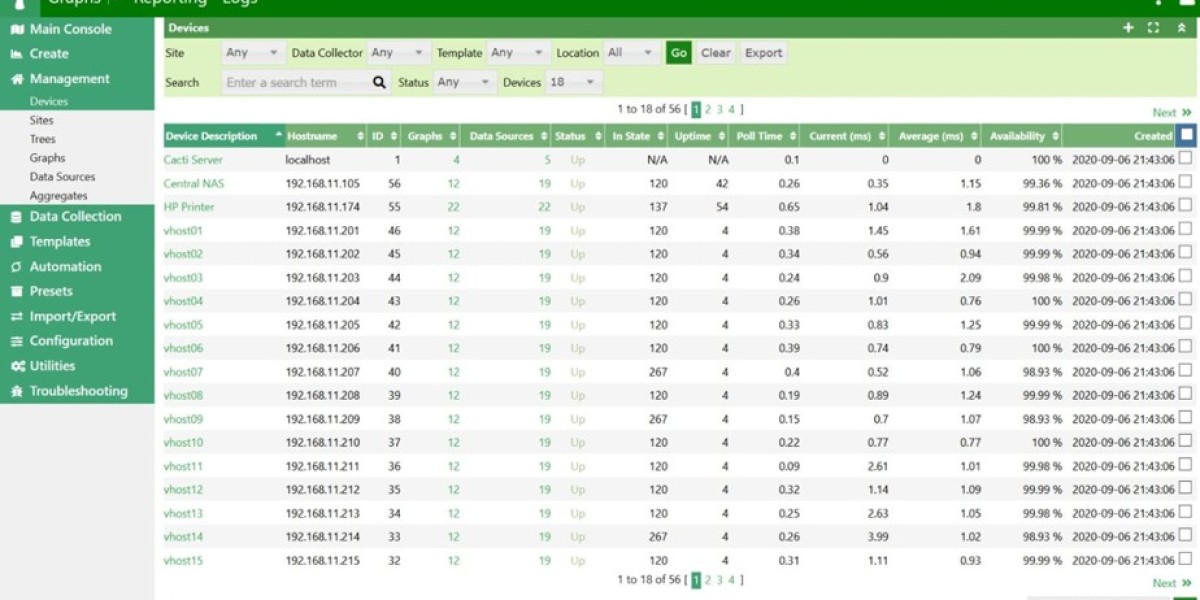Cacti, a long-standing network monitoring system, is a free tool that serves as a front-end for another open-source system called RRDTool. This efficient and lightweight system operates based on the Simple Network Management Protocol (SNMP), which is integral to most network device performance monitoring systems. One of the key advantages of Cacti is that it not only monitors but also discovers network devices, and SNMP is already pre-installed on all network devices.
The origins of Cacti can be traced back to Ian Berry, who was still in high school when he developed the software. Berry was inspired by RRDTool, an open-source package created by Tobias Oetiker. Interestingly, both Berry and Oetiker are self-taught developers who have made significant contributions to the field of network monitoring. Oetiker is also known for creating MRTG and Smokeping, which have influenced many of today's major network monitoring systems.
RRDTool is an excellent choice for monitoring systems because it stores a limited number of time-series values, discarding the oldest data when new readings are added. This feature ensures a constantly updating readout. Other well-known monitoring systems, such as Nagios, OpenNMS, and Zenoss Core, also use RRDTool. However, RRDTool is licensed under the GNU General Public License, which means it must remain free, and any integrated tools must also be free to use.
Ian Berry did not rewrite Cacti to use a different data storage system, even though it might have allowed him to commercialize the tool. The code for Cacti has remained largely unchanged since its initial release in 2001. As of now, the latest version is 1.2.28, released after 23 years of existence.
Berry quickly set up a website for Cacti, registering the domain in January 2000, while he was still working on the project. This indicates his intention to make the system publicly available from the start. Despite being a high school student, Berry was also employed part-time at an internet service provider, making him a very busy individual.
Based in Ann Arbor, Michigan, Berry continued to develop Cacti, albeit slowly, due to his educational commitments. He managed to build a team of part-time developers who contributed to the open-source project for free.
In May 2007, Berry established the Cacti Group, Inc. as a non-profit corporation. By October 2007, Cacti had reached version 0.8.7. In August 2009, the company was re-registered as a domestic profit corporation, replacing the non-profit organization. The company remains registered in Ann Arbor, Michigan.
Between the creation of Cacti and the registration of the company, Berry initiated several other projects. He went on to found other businesses and currently runs three startups, including Nutshell, Cahoots, and Ampll.
The development of Cacti has been gradual, with the push to reach version 1.0 delayed until 2017. The contributors work on Cacti in their spare time, and Berry is involved in multiple projects, limiting the tool's full potential. The business has never sought funding and has not commercialized. Project funds come from sponsors through GitHub's sponsorship scheme, and the company also accepts donations.
Information about the Cacti Group, Inc. is scarce, as the company does not issue press releases or maintain a publicist. Here is a basic timeline of the company's history:
- Ian Berry begins developing Cacti, a graphing tool designed to utilize RRDTool.
- The tool gains popularity among network administrators for its ease of use, scalability, and support for SNMP.
- Cacti is released as open-source software, attracting a community of users and developers who contribute to its growth.
- The software's popularity grows, providing a flexible and cost-effective solution for managing networks of various sizes.
- The Cacti project evolves with regular updates, driven by community contributions, and becomes more feature-rich and scalable.
- Cacti starts to gain recognition with businesses using the free code.
- The Cacti Group, Inc. is initially formed as a non-profit corporation.
- The company is later re-registered as a domestic profit corporation in August 2009.
- Cacti 1.0 is released in January 2017, featuring a modernized user interface, improved performance, enhanced security, and additional customization options.
- The Cacti Group continues to release updates, supporting the latest network protocols and ensuring compatibility with modern IT infrastructure.
- The open-source community remains actively involved, contributing plugins and templates, while the Cacti Group provides direction and support for enterprise-grade features and solutions.
The Cacti Group, Inc. has played a vital role in keeping Cacti relevant, secure, and scalable. The software remains widely used by IT professionals. Ian Berry, the founder and lead developer, continues to guide the technical and strategic direction of the company, balancing his time between Cacti and his other ventures.Ian Berry, the founder of the Cacti project, transferred its ownership to the user community in 2010. Despite this, he remains the president of the Cacti Group, Inc., a role that underscores his continued involvement and influence.
Larry Adams, another key figure, is the current vice president of the Cacti Group, Inc. He is also listed as a director of the company with the Michigan Department of Licensing and Regulatory Affairs. While Adams dedicates most of his time to his primary job as an engineer at Qualcomm, he actively contributes to Cacti in his spare time.
Given Berry's foundational role, it is presumed that he holds a significant, if not majority, stake in the Cacti Group, Inc. The company remains privately owned, with no public listing or detailed information on external investors.
Cacti, the flagship product of the Cacti Group, Inc., is a widely used open-source tool for network performance monitoring and infrastructure management. It caters to a diverse range of industries and businesses, from small enterprises to large-scale organizations. Here’s a closer look at the target market and customer base:
Primary Users:
- IT professionals and network administrators who use Cacti to monitor bandwidth usage, server performance, and network traffic.
Typical Environments:
- Data centers, corporate networks, and cloud services where network uptime and performance are critical.
Value Proposition:
- Scalability from small to large environments, making it suitable for both simple and complex network architectures.
Cost-Effective Monitoring:
- Small and medium-sized enterprises (SMEs) with limited IT budgets benefit from Cacti’s open-source nature, which provides a powerful monitoring solution without high costs.
Customization Needs:
- SMEs often require flexible and customizable tools, which Cacti offers through its plugin architecture and templates.
Scalability:
- Suitable for enterprises with complex, geographically dispersed networks.
Enterprise Support:
- The Cacti Group, Inc. offers professional support and consulting services for large enterprises that need structured support, customization, and integration into existing IT systems.
Network Monitoring for Clients:
- Managed Service Providers (MSPs) use Cacti to provide network monitoring services to their clients, ensuring network performance and identifying issues proactively.
Multi-Tenant Environments:
- Cacti’s ability to monitor multiple networks from a single interface makes it valuable for MSPs managing several client infrastructures simultaneously.
Network Monitoring and Traffic Management:
- Internet Service Providers (ISPs) and telecom companies use Cacti to monitor network traffic, bandwidth usage, and system performance across vast networks of routers, switches, and other equipment.
SNMP Compatibility:
- Cacti’s support for Simple Network Management Protocol (SNMP) allows it to work seamlessly with a wide range of devices common in telecommunications environments.
Cost Efficiency:
- Public sector organizations, such as government agencies and educational institutions, are drawn to Cacti due to its cost-effectiveness and ability to monitor large networks without expensive proprietary solutions.
Customizability for Unique Infrastructure:
- Cacti’s flexibility allows these institutions to tailor the tool to fit the specific needs of their networks, which often include a mix of legacy and modern systems.
The customer base of the Cacti Group, Inc. includes:
- Small and Medium-Sized Businesses (SMBs): These form a significant portion of the customer base, benefiting from Cacti’s low cost and flexibility.
- Enterprises: Internal IT departments and network teams use Cacti to monitor vast and complex networks.
- Public Sector Agencies: Municipalities and federal departments value Cacti for its open-source nature and ability to handle mission-critical infrastructure.
- Universities and Colleges: These institutions rely on Cacti to monitor campus networks, server farms, and research networks, appreciating its low cost and high flexibility.
- Large Telecom Companies and ISPs: These manage massive, global networks and use Cacti to monitor bandwidth usage, track performance, and ensure service availability.
- Managed Service Providers (MSPs): Rely on Cacti to manage network performance for their clients, leveraging its multi-tenant monitoring capabilities.
Key Characteristics:
- Cost-Effectiveness: A highly functional network monitoring tool without high licensing costs.
- Scalability: Suitable for simple single-site networks or scaled up to monitor multi-site global enterprises.
- Customization: Businesses can tailor the software to meet their specific monitoring needs.
- Community and Open-Source Benefits: Community contributions keep the software up-to-date and relevant for evolving network demands.
A versatile open-source solution for tracking IT infrastructure performance, Cacti specializes in visualizing time-series data.
Its graphing capabilities transform collected metrics into clear performance trends over periods.
Data sources range from SNMP polling to custom scripts, enabling monitoring across routers, servers, and databases.
Scalability handles thousands of devices, supported by distributed polling for geographically dispersed networks.
Customizable templates and plugins allow tailoring to unique environments, adding features like alerting.
While offering significant flexibility and zero cost, implementation demands technical expertise.
Recent UI improvements enhance navigation, though initial setup remains complex.
Compared to alternatives, Cacti excels in SNMP monitoring and graphing depth.
Tools like Zabbix provide modern interfaces and discovery, while Prometheus targets cloud-native systems.
Commercial options like SolarWinds NPM offer ease-of-use but lack Cacti's cost advantage.
Maintained by a volunteer community relying on sponsorships, development progresses gradually.
The active contributor base fosters plugin and template sharing despite slower core evolution.
For organizations valuing customization over speed of deployment, Cacti provides a robust foundation.
What is a Netflix VPN and How to Get One
A Netflix VPN is a specialized virtual private network service that enables viewers to bypass geographical restrictions on streaming content, allowing access to shows and movies that are only available in specific countries. When users connect to a Netflix VPN, they can virtually relocate their digital presence to different regions around the world, unlocking libraries of content that would otherwise be inaccessible from their physical location. This technology has become increasingly popular among streaming enthusiasts who want to maximize their subscription value by accessing the full global catalog of Netflix offerings rather than being limited to their local version.
Why Choose SafeShell as Your Netflix VPN?
If people want to access region-restricted content by Netflix unblocked , they may want to consider the SafeShell VPN . 1. The SafeShell VPN boasts high-speed servers that are specifically optimized for seamless Netflix streaming, ensuring you can enjoy your favorite shows and movies without interruptions. 2. It allows you to connect up to five devices simultaneously, supporting a wide range of operating systems such as Windows, macOS, iOS, Android, Apple TV, Android TV, and Apple Vision Pro. 3. The exclusive App Mode feature lets you unlock and enjoy content from multiple regions at the same time, providing a diverse range of streaming services and libraries. 4. With lightning-fast connection speeds and no bandwidth limitations, you can say goodbye to buffering and throttling. 5. Your online privacy is a top priority, with the proprietary "ShellGuard" protocol ensuring top-level security and advanced encryption to protect your data. 6. Additionally, SafeShell VPN offers a flexible free trial plan, allowing users to explore its robust features without any commitment.
A Step-by-Step Guide to Watch Netflix with SafeShell VPN
To begin using SafeShell Netflix VPN for accessing global Netflix libraries, start by subscribing to the service on the official SafeShell VPN website. Select a suitable subscription plan and complete the sign-up process. Next, download and install the SafeShell VPN application specific to your device’s operating system, such as Windows, macOS, iOS, or Android. Launch the app and log in using your newly created account credentials.
For the best Netflix streaming experience with SafeShell Netflix VPN, choose the recommended APP mode within the application. Then, browse the available VPN server locations and connect to a server in the specific country whose Netflix content you wish to unblock, such as the US or UK, ensuring a stable connection. Finally, open the Netflix app or website, sign in to your account, and immerse yourself in the region-specific library now accessible through your SafeShell VPN connection.








